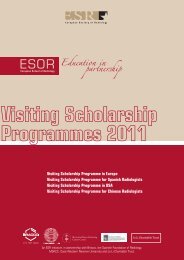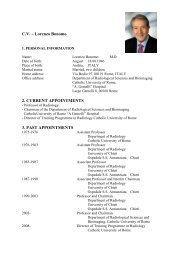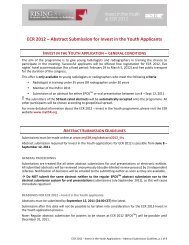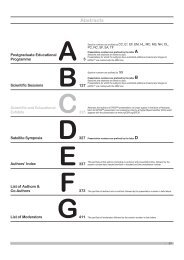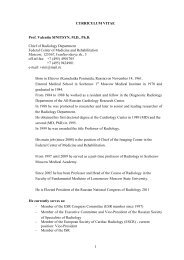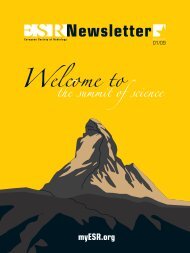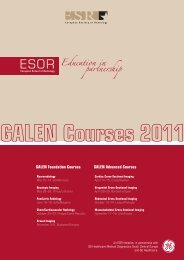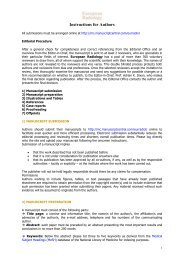Postgraduate Educational Programme - myESR.org
Postgraduate Educational Programme - myESR.org
Postgraduate Educational Programme - myESR.org
- No tags were found...
Create successful ePaper yourself
Turn your PDF publications into a flip-book with our unique Google optimized e-Paper software.
<strong>Postgraduate</strong> <strong>Educational</strong> <strong>Programme</strong>10:30 - 12:00 Room BESR meets SpainEM 1Imaging: essential tool from diagnosis to treatmentWelcome by the ESR President:G.P. Krestin; Rotterdam/NLPresiding:C. Ayuso; Barcelona/ESJ.I. Bilbao; Pamplona/ESA-111 10:30IntroductionC. Ayuso; Barcelona/ES (cayuso@clinic.ub.es)Radiology had been continuously improving since x-rays were discovered by C.Roentgen in 1895, until nowadays. The technological developments had beendramatically followed and new tools and complex procedures guided by meansof imaging techniques had been developed. These facts had been crucial forthe clinical approach of Radiology in the recent decades. The <strong>org</strong>an-system<strong>org</strong>anization of Radiology conducted us to focus in more specific scenarios, allowingus to acquire deep knowledge on specific fields. Knowledge on Radiologyis based on evidence nowadays. This has been the basis of the tremendousimpact of including Radiology in the task of multidisciplinary teams where radiologistshave an interesting role in the decision making process. The sessionwill include three particular scenarios where radiologists have a crucial role fromthe diagnosis of the disease, to the treatment and the follow‐up of the patients.Session Objectives:1. To discuss the role of imaging techniques in different clinical scenarios whereradiologists are key, from diagnosis to treatment.2. To present technical imaging innovations that assist the diagnosis, treatmentand follow‐up in three different clinical scenarios: ischaemic stroke, aorticaneurism and hepatocellular carcinoma.3. To present specific clinical advantages and results of the multimodality approach.A-112 10:35Ischaemic strokeJ. Macho; Barcelona/ES (jmmacho@clinic.ub.es)Interventional neuroradiology (INR) has become an essential tool during the lastdecades in the management of hemorrhagic stroke as well as in the diagnosis andtreatment of the different vascular lesions that may lead to them (aneurysms, AVM’s,Dural Fistulas, etc). However, the role of INR in the treatment and prevention ofischemic stroke has been controversial, with carotid stenting, intracranial stentingand intraarterial techniques in acute stroke, being frequently under debate. Lately,new devices and technology specifically designed for intracranial thrombectomy inacute stroke have shown their effectiveness in revascularization with better reperfusionrates than those achieved with intravenous lytics or previous thrombectomydevices. However, these good revascularization rates were not always correlatedwith good clinical outcomes. Advanced multimodal imaging techniques have beenadvocated as essential in the decision-making algorithm in order to achieve betterlong-term clinical outcomes. Morphological (angioMR - angioCT) and especiallyperfusion imaging techniques (perfusion computed tomography and diffusion andperfusion weighted magnetic resonance) have proved to be effective in the identificationof cerebral penumbra in acute stroke and thus in the selection of patientsfor thrombolytic therapy, being both techniques equivalent in this task. Multidisciplinarstroke teams in which diagnostic and therapeutic neuroradiology plays asignificant role are achieving excellent rates of clinical recovery in this otherwisedevastating disease. We will show algorithm protocols and stroke unit designsspecifically addressed to improve clinical outcomes in those patients selected forIntraarterial treatment and with the aim to increase the number of patients eligiblefor revascularization.Learning Objectives:1. To discuss the clinical and neuroradiologic implications of an early diagnosis.Evaluation of CT and MR diffusion/perfusion in patient selection for endoarterialtreatment.2. To understand the rationale behind mechanical endoarterial reperfusion ofacute vascular occlusion.3. To analyse the short and medium term results of a regional programme foracute stroke treatment after three years.Author Disclosure:J. Macho: Consultant; STRYKER, eV3.A-113 10:55Interlude: Spanish radiologists: open to the worldE. Fraile Moreno; Madrid/ES (eduardo.fraile@salud.madrid.<strong>org</strong>)Founded on February 11, 1917, SERAM, “Sociedad Española de RadiologíaMédica” is the Scientific Society that groups more than 4,700 members amongSpanish radiologist. It is a professional scientific <strong>org</strong>anization dedicated to promotingeducation, research and development of all diagnostic and therapeutic aspectsin relation to diagnostic images. As a society, the main challenges for us are topromote the education of radiologists and courses sponsored and run by SERAMare available for radiologists throughout all of their training. We also hold coursesfor senior radiologists in specific areas of interest such as oncology, molecularimaging or vascular diseases. SERAM also provides grants to attend differentmeetings like the ECR in Vienna or RSNA in Chicago and grants in research incollaboration with different companies involved in radiology. Another of SERAM’scontributions include promoting the sharing of knowledge creating and releasingdifferent types of publication. Our official journal is called “Radiologia.” it is the onlySpanish radiological publication in PubMed, and is also included in the GORADportal of radiology magazines. The english version is also available online on ourwebsite www.seram.es. Other contribution that SERAM makes are available onour website is the virtual library. In 2009, with the support of SERAM, the book“Radiologia Esencial” was published. Establishing standards and references isanother of SERAM’s contributions, since the year 2000, we have published thereference book of current procedural terminology.A-114 11:00Aortic aneurismsJ.J. Martínez Rodrigo; Valencia/ES (martinez.jjo@gmail.com)Aortic aneurisms are a potentially devasting condition if misdiagnosed or notearly detected and corrected. Aortic aneurism rupture prevention with a properimaging follow‐up and treatment indication are essential to provide a standard ofcare to these patients. Screening programs among elderly and risk patients havebeen addressed to detect patients with aortic aneurysms amenable to follow‐upor treatment. Multidisciplinary teams focused on early detection and treatments ofthese pathologies have improved the outcomes of this disease. We will describestrategies to develop a multidisciplinary approach to early detection and diagnosisof aortic aneurisms and will describe our experience. Stent graft devices allowedinterventional radiologists and other specialists a less-invasive approach to treataortic patients but new challenges derived from this new treatment related to endovasculartreatment complications. The simple bifurcated technique has evolvedto treat complex abdominal and thoracic aneurisms by means of fenestrated graftsand branched devices. The totally percutaneous approach with the new low-profiledevices and percutaneous suture techniques is a fact. Imaging again is the leadingtool allowing us to improve outcomes. We will discuss imaging role in increasingsecurity in performing and guiding these interventions especially in 3D guidingimaging. Radiologists play also a major role in the follow‐up of stent grafts to detectendoleaks and other complications. Finding the right approach to solve theseproblems is mainly dependant on imaging techniques that provide interventionalradiologists the tools to plan the adequate treatment strategies.Learning Objectives:1. To understand the role of imaging modalities in diagnosis and endovasculartreatment of aortic aneurisms.2. To learn about the role of 3D imaging techniques to assist the endovasculartreatment of aortic aneurisms.3. To appreciate the role of imaging modalities in evaluating the complicationsof endovascular aortic repair.A-115 11:20Interlude: Radiologists and Spanish winesL. Martí‐Bonmatí; Valencia/ES (marti_lui@gva.es)Why are wines different? Which is the influence of the country, the climate andthe situation. Why is the soil (and by extension terroir) so important? A wine froma particular patch of ground expresses characteristics related to the physical environmentin which the grapes are grown. A combination of certain vineyard sitesand grape varieties creates unique wines that faithfully express their geographicalorigins. But, how do soils affect wine quality? Is it a direct or indirect relationship?What are the scientific explanations for terroir effects? How many soils are presentin wine-producing regions? The miracle of the plant kingdom is that these complexS32AB C D E F G



